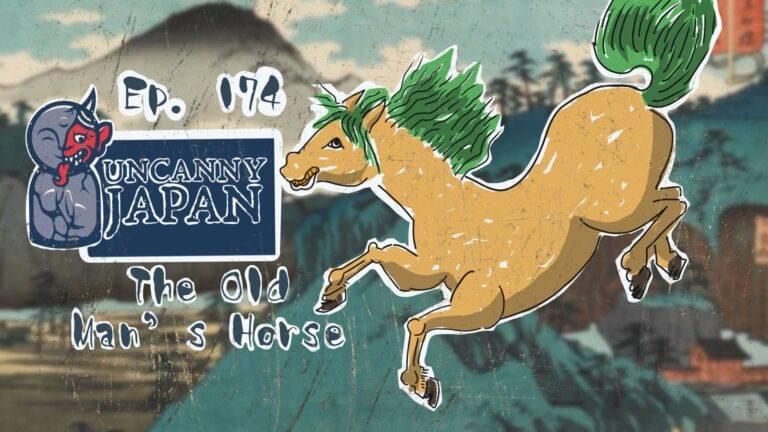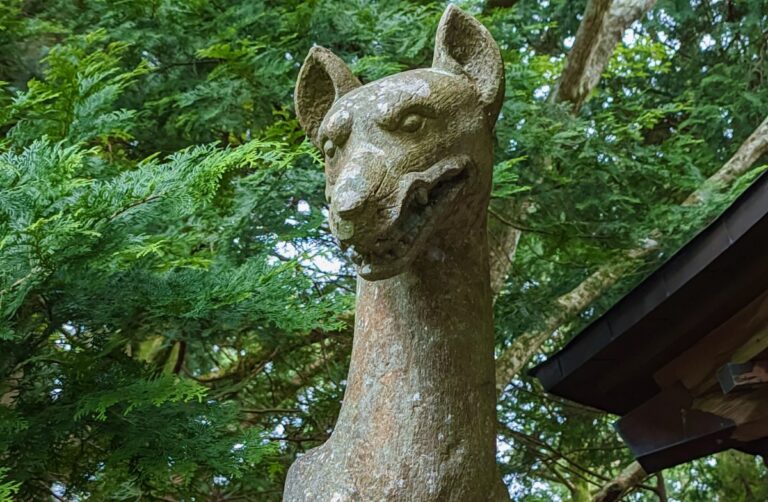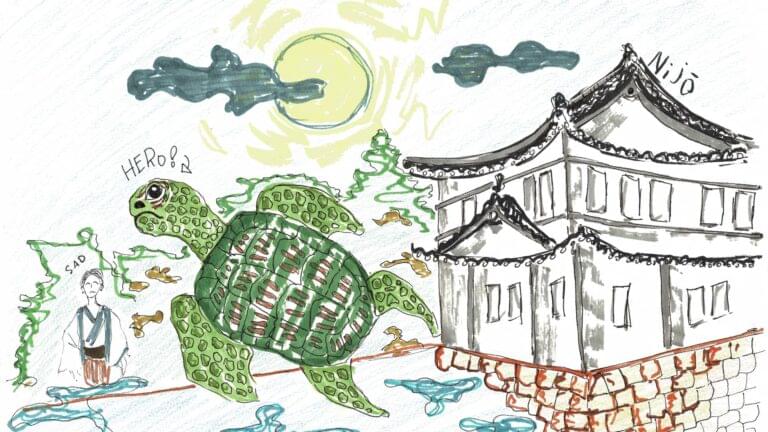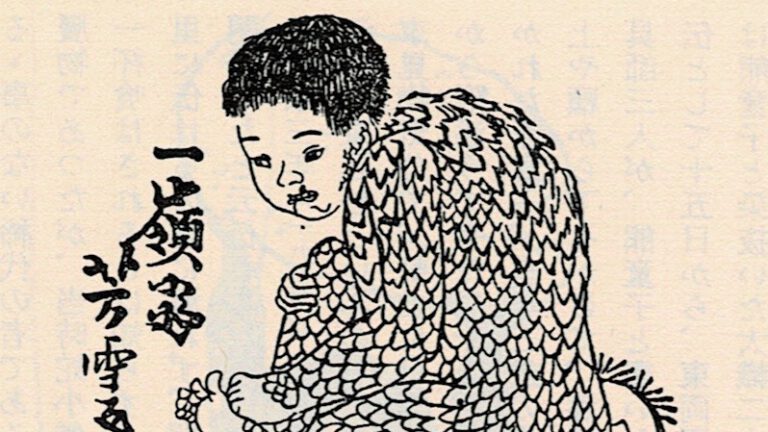How do you build a bridge that stands up to storms and floods? Well, you have to appease the nature gods, of course. But how do you do that? Human sacrifice seemed to have worked in the past. Today I’ll talk about hitobashira or human pillars. An ancient tradition of insuring strong river banks, fireproof castles, and tunnels that won’t collapse.
Hey hey, You’re listening to Uncanny Japan, this is Thersa Matsuura and when was the last time I talked about something dark and disturbing?
(Music)
It’s been awhile, right? Okay, let’s do something a little cringe worthy today.
But first you have to imagine you’re living back in an older Japan. Also, you’re a bridge builder and you’ve been given the job of building a bridge; which is fine, you’re confident, you can do this, you’ve done it before.
But once you start, you find you’re suddenly plagued by all kinds of bad luck. A storm rolls in, there’s flooding, your materials and at least two of your best workers get washed away, and then while you’re dealing with that, there are handful of other workers suddenly complaining about strange injuries and mysterious illnesses.
It’s almost like someone or something doesn’t want you to build that bridge. A nature spirit perhaps? One of the many Shinto gods?
So what can you do to remedy this situation? Both get the bridge built and appease that angsty deity who is so unhappy about the whole thing?
Well, one option that was believed to work was something called a hitobashira (人柱).
If you know even a little Japanese, you just cringed right there. Let me explain, the word hitobashira is made up of the characters for person and pillar, a person pillar. Can you see where we’re going with this? Yes, one of the best ways to placate the gods or spirits used to be human sacrifice. That’s nothing new to you or me. But the type of human sacrifice here is a little unnerving, and the fact if you live in or have been to Japan and traveled to any major sightseeing destinations, especially castles, there very well might still be the skeletal remains of one or more of these hitobashira buried there still.
On today’s show I’ll tell you what I’ve learned about this terrible and heartbreaking practice that occurred from olden times all the way up through the 16th century, and maybe, as recently as the 20th century. But I don’t think you’re going to get anyone to admit to that.
If this squicks you out, just stop right here and give Tanuki Buttons another listen. But if you’re even a little bit morbidly curious, then don’t change that dial.
Hey there and speaking of Tanuki Buttons, Uncanny Japan has been nominated for a podcast award. There’s something called the New Jersey Film Festival and from this year, because of the pandemic perhaps, they have opened a new category for podcasts.
Richard and I just happened to be in the States when they live streamed the shows that got into the final running and we made it with the delightfully WTF April Fool’s episode, Tanuki Buttons. If you’ve haven’t listened to that one already, it’s a hoot. I highly recommend it. The winners will be announced this fall. So that’s exciting.
Something else to look forward to is our next immersive show. Remember Episode 49, “Close Encounter with and Amabie” and Episode 52, “Putting a Curse on Your Enemies”, and of course “Tanuki Buttons”? Well, mark your calendars for the end of October when I’ll be doing something spooky for around Halloween.
The First Hitobashira Written Document
Okay. What’s the sacrificing people, hitobashira thing?
First off, the practice of hitobashira wasn’t exclusive to Japan. There is evidence of it occurring in China, Korea, Burma, and Indonesia as well as other places. But even though I thoroughly upset myself reading up on those, that’s not what I’m going to go into. Today I’m going to tell you about what I learned as it happened here in Japan.
It looks like the first record of hitobashira can be found in the Nihon Shoki which told a story that supposedly took place in the early 300s AD. Here is written an account of two rivers (the Kita-Kawa and the Mamuta-Kawa) that kept flooding and causing all sorts of damage and loss of life. The Emperor at the time, Emperor Nintoku, had a divine vision in one of his dreams that was oddly specific.
He was told that there was a person named Kowakubi who lived in the province of Musashi (think the Tokyo and Saitama area), and another person with the delightful name of Koromono-ko who lived in the province of Kawachi (think Osaka). Emperor Nintoku was told if these two people could be found and thusly sacrificed, one to each of the river gods, then the flooding and devastation would stop. The river bank would hold. Before they knew what was what, both Kowakubi and Koromono-ko were found and captured. First, poor Kowakubi was hurled into the Kita Kawa where he drowned. Prayers were made and a nice solid riverbank was constructed.
Next it was Koromono-ko’s turn. But he in an exquisite move worthy of a Monty Python skit, had an idea. On the day he was to be sacrificed in the Mamuta River he held up two guards and addressing the river god directly said:
“I came here to sacrifice my life to thee, because thou art inflicting the calamity upon the people of this district. If thou dost sincerely want my life, sink these gourds so that they may not float again. Then I shall know thee as the true diety of this river and offer my body to thee. But if thou canst not sink them, thou are not the true deity and it would be in vain for me to throw away my life.”
And with that he tossed in the gourds. A wind picked up whirling about as if trying to sink them. But, they did not sink. What did happen though was that same wind dissipated and the river calmed and the bank decided it would hold from then on and no longer break. Koromono-ko was freed!
What is Hitobashira Exactly?
Anyway, later on when you start hearing about Hitobashira, it happened more when something significant was being built: bridges, tunnels, dams, castles, and stuff like that.
Okay, but what is it exactly? Hitobashira is when a person is buried alive in the ground or into some sort of coffin, sometimes placed into the structure or mountain or river bank itself, sometimes just submerged under water until dead.
The thinking went, as it kind of did everywhere back then, that performing this ritual would pacify the gods and would protect that very important structure from being destroyed by any natural or manmade disaster. A manmade disaster would be enemy attacks. This is why you can find a whole lotta castles in Japan that were built with hitobashira sacrifices performed.
Another Meaning to the Word
It’s interesting to note that there’s a double meaning to the word hitobashira, too. While it literally means human pillar, the character for pillar is also used in Shintoism as a counter for a god, remember the Shinto religion has a whole bunch of gods. So hitobashira, person and the counter for a god, indicates that the person sacrificed is enshrined and is now connected to the gods. The bridge, tunnel or castle, now has the soul of that person attached to it, which makes it much stronger than a soulless structure.
But Thersa, you ask, wouldn’t the soul or spirit of a person who is literally being buried alive be rightfully revengeful and ill tempered? I mean, I would be. Well, I’d say, You and me both.
But, that’s been thought out. That’s what the fancy ceremony before the killing is for. Because a person isn’t just snagged and sacrificed (Well, except for poor Kowakubi, rest his soul), there is a very precise ritual to calm the spirit of the person or persons who are about to be made into hitobashira.
And also, if you consider what I said about the connection to Shintoism and gods, if you were promised to be elevated to godlike status and be worshipped through the ages wouldn’t you do it? Yeah, me neither.
But at least in Japan they seemed to have tried to honor that promise. Quite often there would be some sort of shrine or cenotaph built nearby for people to visit to offer prayers. There are even some now still in place. So they are in effect, being not forgotten, worshiped and thanked for their sacrifice through the ages.
There are so many stories and legends of hitobashira. But as an example of the above let me tell you this one.
The Tale of Hiji
In 1331 a man named Toyofusa Utsunomiya was in charge of constructing the Oosu Castle. But as it happens for whatever reason they were having trouble building the stone wall. It was decided to have a lottery (yes, just like the Shirley Jackson story of the same name). A young girl named Ohiji won, or in this case lost. As a part of the deal, in her will she asked that the river that ran through the castle grounds be named after her. So Hiji Kawa, Hiji River, it was. This soothed her soul. If you go to Shikoku you can find Hiji River and tour bus guides tell this same story of her sacrifice.
The Tale of the Monkey River Bank/Saru Dotte
Here let me tell you another story about a place in Tottori Prefecture called Miyoshi no Saru Dotte.
Back in the day the banks of the river overflowed a lot and washed sand into the rice fields, ruining them. This happened again and again. One of those times the villagers all went out to see the bank that usually built up had been washed away. Someone said, Hey I have an idea. I heard when Yonago Castle was being built there were landslides on the mountain nearby stopping construction. They chose someone and did the hitobashira thing and were able to finish the castle with no more incident.
Great idea everyone agreed. But, geez, how does one decide who in the village to murder for this protection? To which another great idea emerged.
How about we take the first person to walk in front of this bank tomorrow morning?
Yeah, okay. That’ll work. So early the next morning they all gathered and waited for the poor soul who was destined to be their hitobashira. I can only guess they were hiding or trying to act inconspicuous.
Imagine their surprise when the first person to stroll pass the river bank was a man with a monkey on his shoulder. Remember I talked about sarumawashi (猿回し) way back in Episode 4, Monkeys and Monkey Lore. They were the men who had pet monkeys and trained them to perform dances and acts for both entertainment and good luck.
This man was a sarumawashi and not only that ironically enough he was famous because his monkey did this cute routine where he pretends to be reflecting sadly on something, his short life perhaps.
Anyway, the crowd had made up their mind. They grabbed the man and his pet and with the monkey still on his shoulder buried him alive. The bank never broke again and to this day it’s called The Monkey Bank, or Saru Dotte. It’s also still there.
That story is on the Yonago City website but at the end of it there is a cautionary note about how this might be true or not, or might be a little bit true. We’ll never know.
Extra Stories as Extra Content
There are quite a few of these short little legends of hitobashira, as well as one I found that is longer and explains more detail into the actual ceremony of one particular hitobashira ritual using a Shinto miko (巫女) , which is often translated as shrine maiden, as the one to be sacrificed. I’ve already put up a folktale for this month’s patrons, but I’m going to translate and read several more of these dreadful yet little tales and the longer one, too, and put it up there. So if you’re a $5 a month and up patron, keep an eye out for that.
If you’ve always thought about becoming a patron to help support the show and want to get a whole bunch more Japanese folktales and myth to listen to, that would be very cool and I’d really appreciate it. I’ve got a mini goal of getting 300 patrons by the end of the year. I’m at 230 at the moment.
I’ll also put those extra stories up on Buymeacoffee, so if you would like to hear just them and don’t necessarily want to get continuing monthly folktales/Bedtime Stories or the back stories, you can search for Buymeacoffee, all one word and Uncanny Japan, and I’ll pop up.
Okay, before I go two more interesting tidbits about hitobashira.
Two Pieces of Hitobashira Trivia
The first one is how the word has come to have two meanings. We now know about a human sacrifice in order to mollify irritated gods or spirits. But, also, if a person or people die while something is being built, an accident of some sort, they’re labeled as hitobashira. Even though it wasn’t planned that way.
And the second interesting fact is do you remember zashiki warashi, those little ghostly children that haunt certain houses and inns? I talked about them awhile back, Episode 47, “The Guest Room Child”. Well, some say they are actually the spirits of children who were sacrificed as hitobashira.
That’s all for today, thank you so much for listening. I’ll be putting up those extra stories I mentioned very soon. Please stay safe and healthy and don’t go walking on riverbanks first thing in the morning. I will talk to you in two weeks.
Bye bye.
Credits
Intro and outro music by Julyan Ray Matsuura.
Sincerely by Kevin MacLeod
Link: https://filmmusic.io/song/5033-sincerely
License: https://filmmusic.io/standard-license
Lights by Rafael Krux
Link: https://filmmusic.io/song/5309-lights-
License: https://filmmusic.io/standard-license
Lost Place Atmospheres 003 by Sascha Ende®
Link: https://filmmusic.io/song/7675-lost-place-atmospheres-003
License: https://filmmusic.io/standard-license







cool